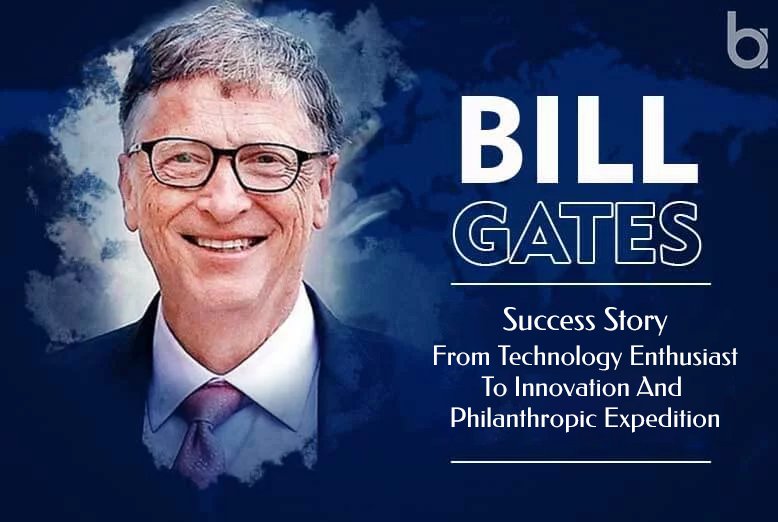Bill Gates’s journey of success was not another rags-to-riches story. Born in 1955, William Henry Gates III was born and raised in Seattle, Washington within a fairly wealthy family. His father, a lawyer, and his mother, board of directors for First Interstate BancSystem and the United Way of America, encouraged competition within him. Being a bullied child, Gates was inspired to seek for better.
Gates developed a passion for computers and programming at an early age. He was a brilliant student who performed exceptionally well in academics, especially in the subject, Mathematics. In 1975, he co-founded Microsoft along with his partner Paul Allen and became the world’s renowned self-made billionaire.
Bill Gates Success Story: The era of Microsoft
1968: Building the first program

13-year-old Gates was enrolled in the Lakeside Prep School where he wrote his first program. While in 8th grade, he developed an interest in programming the General Electric system in BASIC and was excused from classes to pursue it. And hence, Gates built his first program in the General Electric machine.
He met Paul Allen at the school where they worked together to find bugs in the PDP-10 system belonging to Computer Center Corporation. Gates, Paul and two other students wrote a payroll program for Information Sciences in exchange for computer time and royalties. It created a lot of buzz when the entire school became aware of Gates’s programming skills.
1972-75: Venture, Harvard, and the MITS Altair

17 years old Gates started a venture called Traf-O-Data with Paul to make traffic counters based on Intel 8008 processors.
In 1973, he graduated as a National Merit Scholar and enrolled at Harvard College in the following autumn. Gates, however, did not have a study plan at Harvard and spent a lot of time using the computers.
In 1974, he joined Paul at Honeywell and in 1975, the MITS Altair 8800 based on Intel’s 8080 CPU was released.
Bill and Paul saw this as an opportunity to start their own software company.
1975-76: The Emergence of Microsoft

In 1975, Gates tried to gauge MITS’s interest. He came across an article demonstrating the Altair 8800 and contacted MITS to inform them about the BASIS interpreter for the platform.
Surprisingly, Gates and Allen did not have any code written. They met with the MITS president and developed an Altair emulator in a short time to demonstrate on a minicomputer and the BASIC interpreter.
The meeting was an instant success that helped Gates and Allen bag a deal with MITS to distribute the interpreter as Altair BASIC. Paul Allen was hired into MITS and Gates took a leave of absence from Harvard to work with Allen in November 1975. The partnership was named Micro-soft.
A year later, the hyphen was dropped and on 26 Nov 1976, the trade was registered as Microsoft Corporation.
1980-90: IBM X Microsoft

In 1980, IBM approached Microsoft to write a BASIC interpreter for the new IBM PC. It formed a partnership with IBM to bundle its operating system with the IBM computers. Under that deal, IBM paid Microsoft royalty for every sale.
Despite IBM’s name on the operating system on the operating system, the press quickly identified Microsoft as being very influential on the new computer. The computer was called by an expert in the industry as “Gates computer”. The company was restructured in 1981, Gates became the president and board chairman.
1985: OS/2 vs Gates Computer

In 1985, Microsoft launched its first retail version of Microsoft Windows. The same year, IBM requested Microsoft to develop a new operating system for their computers called OS/2.
Although Microsoft continued producing that operating system, it also continued to sell its own alternative that was in direct competition with the OS/2.
Post-1990: World’s Personal Computers

When Microsoft launched several versions of Microsoft Windows in the 1990s, they had captured over 90% market share of the world’s personal computers.
In the future, Microsoft’s partnership with IBM deteriorated due to creative differences. However, ever since, Microsoft has not looked back and went on to create a history within the software industry.
When Bill and Paul Allen started Microsoft, their vision of a computer on every desktop and in every home seemed farfetched to most people. Today, owing to Microsoft and several other companies, that vision has become a reality in various parts of the world—with personal technology becoming an integral part of society.
The Era of Charity and Philanthropy
1994-2010: The years of Philanthropy

Bill Gates’s success is not confined to the success of Microsoft and the further ventures. Being a philanthropist has earned him immense recognition and success throughout the world.
In 1994, Gates started his foundation—William H. Gates Foundation—by selling some of his shares in Microsoft.
In 2000, Microsoft launched its Windows 95 and in the same year, Gates established the charitable Bill & Melinda Gates Foundation.
In 2001, he became the Chief Software Architect of Microsoft after Steve Ballmer assumed the role of CEO.
In 2008, when Microsoft launched the original Xbox, Gates quit his daily job at the company.
In 2010, Bill Gates, Melinda Gates and Warren Buffet altogether launched ‘The Giving Pledge’. It was a commitment by the world’s wealthiest people to dedicate most of their wealth to philanthropy.
2014: Stepping down from the post
In 2014, Gates officially stepped down as the Chairman. However, he continued remaining on the board and served as the technology advisor.
Since the time he has stepped down from the board, Gates has hardly had any involvement in the day-to-day operations of Microsoft.
2015-Present: Philanthropic Investments

Most of Gates’s time is spent on philanthropic activities and partaking in community projects. Bill Gates has co-founded several foundations. More than 80% of his wealth is pledged to the ‘Giving Pledge’ charity upon his death.
In 2015, he launched a $5.5 billion effort to eradicate polio by 2018.
In 2017, he announced the formation of the Child Health and Mortality Prevention Surveillance Network (CHAMPS) to help prevent childhood deaths.
In 2018, Bill joined forces with a group of philanthropists to create the Diagnostics Accelerator, a program aimed at finding a way to diagnose Alzheimer’s earlier.
In March 2020, Gates left his board positions at Microsoft and Berkshire Hathaway to focus on his philanthropic efforts including climate change, global health and development, and education.
Gates inclination towards sustainable technology and clean and green technology is reflected in his philanthropic interests. In December 2020, he called for the U.S. federal government to create institutes for clean energy research, analogous to the National Institutes of Health.
To date, Gates continues to be involved in various philanthropic and community projects. The world’s self-made billionaire is a true example of how the road to becoming successful begins not only with a successful business venture but also with empathy and philanthropy.
‘Bill Gates success story’: What did we learn?
The ‘Bill Gates success story’ began with an idea and a vouch to not lose hopes amidst times of downfall. Today, Bill Gates continues to be an inspiration for a majority of the world and is a role model for many. Following are some keynotes from his success story:
- Believe in your passion
- Never lose hope during challenges
- Find your passion and build a venture around it
- Be focused on your goals and persistently pursue them!
“Success is a lousy teacher. It seduces smart people into thinking they can’t lose.” – Bill Gates.
End Note
As we conclude our journey through Bill Gates success story, we realize that Bill Gates transformed not just the tech industry, but the world.
Bill Gates’s success proves that innovation combined with a giving spirit can create a lasting impact. Ready to start your own journey of change? Follow the footsteps of one of the greatest minds of our time and take the next step toward your dreams today.
Furthermore, if you’re inspired by his story, share it with all your friends and follow in the footsteps of one of the greatest minds of our time together.
‘If you’re ready to shape your own legacy, take inspiration from his story—your success could change the world too.’
FAQs
How did Bill Gates become successful?
Bill Gates became successful by co-founding Microsoft, revolutionizing personal computing, and building a global tech empire. His passion for technology, innovation, and strategic business decisions played a key role in Bill Gates success story.
What are Bill Gates’s 10 rules for success?
Bill Gates’s 10 rules for success include setting clear goals, staying curious, learning from failure, focusing on impact, thinking long-term, embracing innovation, working hard, seeking feedback, collaborating with others, and giving back to society. Therefore, Bill Gates success story is built on these principles.
How does Bill Gates define success?
Bill Gates defines success as making a positive impact on society and improving the lives of others. However, Bill Gates success story is not just about wealth but about using his resources to solve global challenges.
Why is Bill Gates so popular?
Bill Gates is so popular because of his groundbreaking success in creating Microsoft, his role as a tech visionary, and his philanthropic work through the Bill & Melinda Gates Foundation. His success story continues to inspire millions worldwide.
Why did Bill Gates start Microsoft?
Bill Gates started Microsoft to bring personal computing to every home and business. His vision to make computers accessible to everyone is a key part of his success story.
Read more: Is Ratan Tata Actually A Billionaire?















